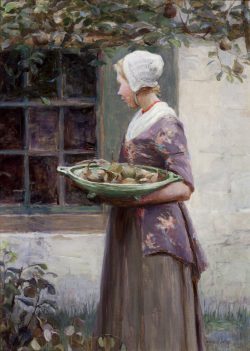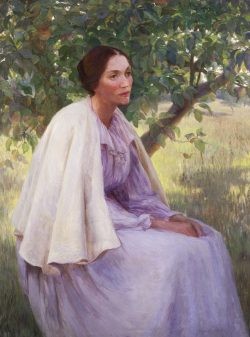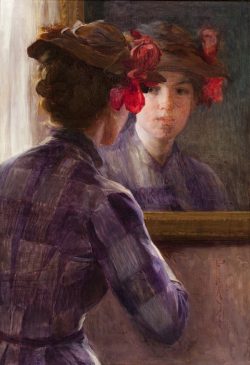Pauline Dohn, from a photograph, circa 1890s, Fay Rudolph Little Family Collection.

Pauline Dohn (Rudolph) 1865–1934
Pauline Amalie Dohn was born in Chicago to a family that appreciated the arts. She graduated from high school at age fifteen and then studied at the Chicago Academy of Fine Arts (predecessor of the Art Institute of Chicago). In 1881, she was among a group of young women artists who founded the Bohemian Club (later the Palette Club), where she began exhibiting her paintings. In 1884 Dohn enrolled in the Pennsylvania Academy of the Fine Arts in Philadelphia; her studies there under renowned realist painter Thomas Eakins and his former student Thomas Anschutz included anatomy as well as figure painting. Dohn then departed for Europe, enrolling in the popular Académie Julian in Paris. On her travels in rural northern Holland and in Italy and Germany, she painted landscapes as well as figural works. A study of a head she showed in the Paris Salon exhibition of 1888 received honorable mention. That year, Dohn returned to Chicago, where she continued to exhibit to critical praise at the Palette Club. In 1892–1893 she served as the club’s president. She also began teaching in the Art Institute’s thriving school, with which she was associated until 1902.
In 1893, Dohn’s decorative frieze on the theme of industrial art adorned a room in the Illinois Building at the World’s Columbian Exposition in Chicago. Shortly after the fair opened, Dohn returned to Paris for more than a year of further study, this time at the Académie Colarossi. Her portrait of her sister won the $300 Yerkes Prize in the Chicago Society of Artists’ annual exhibition of 1895. Dohn then spent a summer painting peasant subjects and landscapes in rural Holland with American artists George Hitchcock and Gari Melchers; she also visited Madrid. Back home she exhibited nationally and expanded her creative range, painting a decorative landscape for the interior of the Charles E. Roberts House, then being remodeled by Frank Lloyd Wright, in suburban Oak Park. On summer excursions in the Midwest and Northeast, Dohn made sketches that became the basis for many landscape paintings. A member of the artists’ community in Chicago’s Tree Studios building, where her friends included Frederick W. Freer, Dohn was involved in several important local art endeavors, notably the inauguration in 1897 of the Art Institute’s annual Chicago artists’ exhibition (later dubbed the “Chicago and Vicinity”).
At the height of her career, in 1901, Dohn married businessman Franklin Rudolph. With the births of three children by 1908, she greatly curtailed her artistic practice, but she remained active as a leader in art and civic affairs in Chicago and in suburban Winnetka, where she settled with her family. By the time of her death, in 1934, Pauline Dohn Rudolph was living in Southern California.
Wendy Greenhouse, PhD


